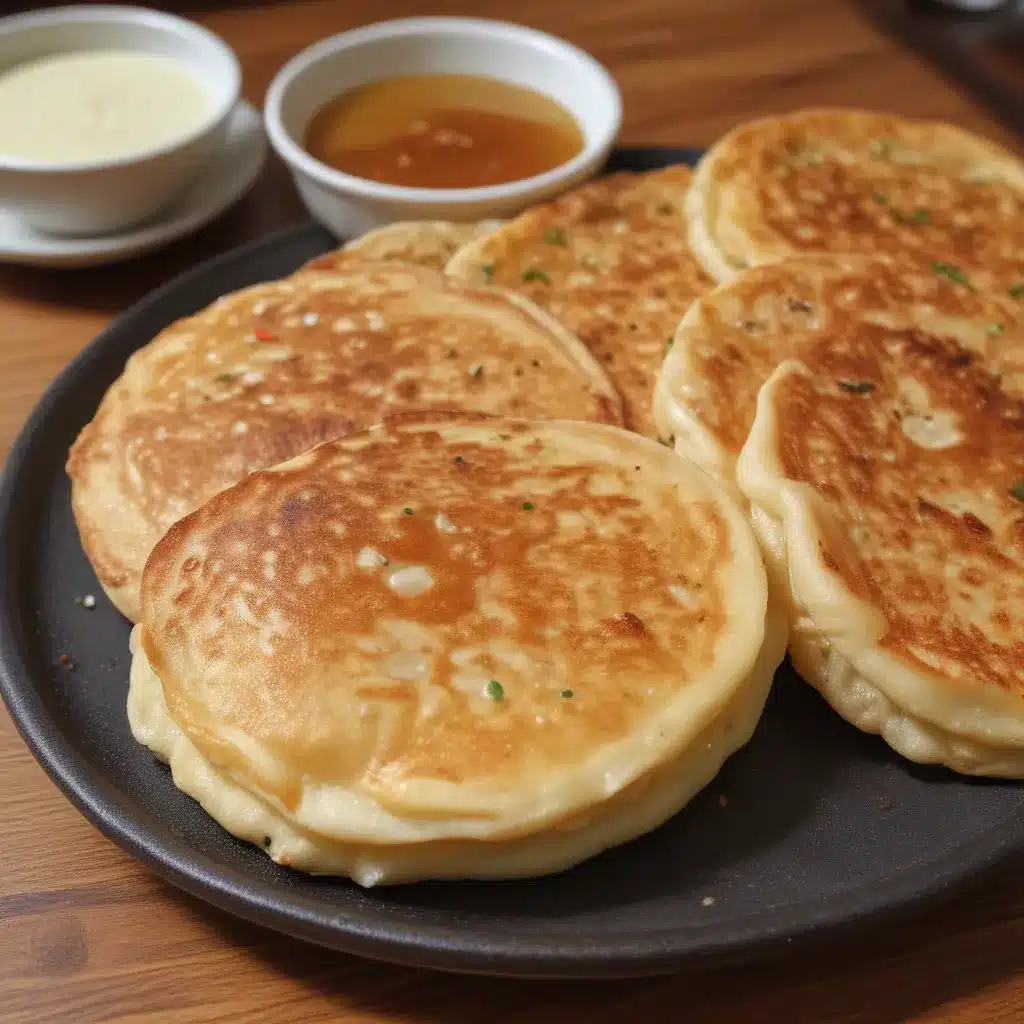
Flipping into the Flavors of Korea
If you’ve ever traveled to the bustling streets of Seoul, you’ve undoubtedly encountered the alluring scent of sizzling pancakes wafting through the air. These Korean delights, known as “jeon,” are more than just a humble fried batter – they’re an enchanting dance of textures and tastes that captivate the senses.
As a self-proclaimed pancake enthusiast, I’ve made it my mission to uncover the magic behind these scintillating creations. And let me tell you, it’s been a delicious journey! From the savory scallion-studded pajeon to the sweet and nutty bindaetteok, each Korean pancake offers a unique flavor profile that will have you craving more.
Diving into Pajeon: The Salty Sensation
One of the most beloved Korean pancakes is the pajeon, a savory masterpiece that combines the crunch of scallions with the umami-rich batter. [1] The secret to the pajeon’s addictive nature lies in the perfect balance of salty and crispy. The batter, made with a combination of wheat flour, rice flour, and soy sauce, creates a golden-brown exterior that shatters beneath your fork, giving way to the tender, verdant scallions within.
But the true star of the pajeon is the dipping sauce, a tangy and slightly spicy concoction that complements the pancake’s savory essence. [2] Some variations even incorporate seafood, like shrimp or squid, adding an extra layer of complexity to the already captivating dish.
As I stood in the bustling Gwangjang Market in Seoul, watching the skilled ajummas (Korean auntie) deftly flip the pajeon, I couldn’t help but be mesmerized. The sizzle of the hot oil, the fragrant steam, and the satisfied hums of the locals all contributed to a sensory experience that I knew I had to recreate in my own kitchen.
Embracing Bindaetteok: The Sweet and Savory Surprise
While the pajeon might steal the spotlight, the bindaetteok deserves equal attention. This Korean mung bean pancake is a study in contrasts, with a crisp exterior that gives way to a soft, almost creamy interior. [3] The mung bean batter is mixed with a medley of finely chopped vegetables, like onions, kimchi, and bean sprouts, creating a harmony of flavors that dance on your tongue.
What sets the bindaetteok apart is the addition of a touch of sweetness, often in the form of a drizzle of honey or a sprinkle of sugar. This subtle sweetness balances the savory elements, resulting in a pancake that is both comforting and captivating.
As I sank my teeth into my first bindaetteok, I was transported back to my time in Busan, where I had stumbled upon a bustling street vendor serving up these delectable pancakes. The vendor, an elderly gentleman with a warm smile, had insisted that I try his “famous” bindaetteok, and I’m forever grateful that I listened.
Embracing the Art of Korean Pancake Making
The art of Korean pancake making is not to be taken lightly. It’s a delicate dance of precise measurements, perfect batter consistency, and impeccable timing. [4] But don’t let that intimidate you – with a little practice and a lot of enthusiasm, you too can master the art of Korean pancake perfection.
One key to success is the batter itself. The right ratio of flours, the perfect amount of seasoning, and the proper hydration all play a crucial role in achieving that coveted crisp exterior and tender interior. And don’t forget the importance of letting the batter rest – this allows the starches to fully hydrate, resulting in a pancake that is light and airy.
But the real magic happens in the pan. Whether you’re using a traditional cast-iron skillet or a modern nonstick surface, the key is to maintain a consistent, medium-high heat. This ensures that the pancake cooks through without burning the exterior. And when it comes to flipping, a gentle, confident motion is the way to go – no need for any fancy acrobatics.
Embracing the Diversity of Korean Pancakes
Korean pancakes are not a one-trick pony. In fact, the diversity of these delectable discs is truly astounding. From the savory and seafood-laden jeon to the sweet and nutty hoddeok, there’s a Korean pancake to suit every palate. [5]
Take, for instance, the haemul pajeon, a pajeon that incorporates a bounty of fresh seafood, like shrimp, squid, and even tiny anchovies. The brininess of the ocean perfectly complements the crisp scallions and salty batter, creating a truly remarkable flavor experience.
On the sweeter side, the hoddeok is a revelation. This circular pancake is filled with a warm, gooey mixture of brown sugar, cinnamon, and sometimes chopped nuts, creating a decadent, almost dessert-like treat. [6] The contrast between the crisp exterior and the molten interior is nothing short of mesmerizing.
And let’s not forget the delightful variation that is the kimchi jeon. This pancake showcases the bold, fermented flavors of kimchi, combined with the comforting texture of the batter. It’s a true testament to the depth and breadth of Korean cuisine.
Embracing the Joy of Korean Pancakes
As I sit here, savoring the last bite of my bindaetteok, I can’t help but feel a sense of joy and wonder. These Korean pancakes have become more than just a culinary delight – they’re a window into the rich tapestry of Korean culture, a celebration of the country’s diverse flavors and traditions.
Whether you’re indulging in the savory delights of the pajeon or the sweet surprises of the hoddeok, one thing is certain: Korean pancakes have a way of captivating the senses and leaving you craving more. So, grab a fork (or chopsticks, if you’re feeling adventurous), and join me on this delicious journey of Korean pancake discovery. Trust me, your taste buds will thank you.
References:
[1] Knowledge from https://sf.eater.com/maps/best-chinese-restaurants-san-francisco
[2] Knowledge from https://www.thestranger.com/pride-2023/2023/06/26/79051746/roldy-aguero-ablao-consecrates-ancestry
[3] Knowledge from https://www.quora.com/What-does-Chinese-food-taste-like-And-is-it-spicy
[4] Knowledge from https://www.farmfreshfeasts.com/2014/06/cold-and-creamy-pea-avocado-and-mint.html
[5] Knowledge from https://www.yelp.com/search?find_desc=Umami+Burger&find_loc=Atlanta%2C+GA
[6] Knowledge from https://m.yelp.com/search?find_desc=Yolk&find_loc=Los+Angeles%2C+CA
